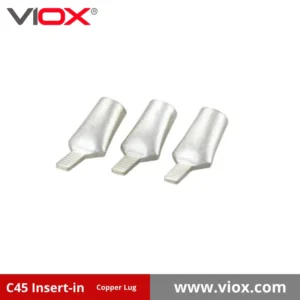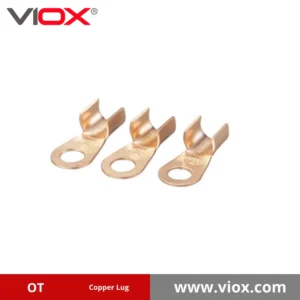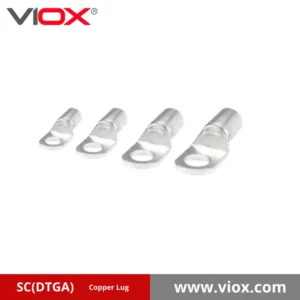DTL Copper-Aluminium Lug
VIOX DTL Copper-Aluminium Lug ensures safe transitions between aluminium cables and copper terminals. Its bimetallic design with friction-welded joint prevents galvanic corrosion, ideal for power distribution and substations. Trust VIOX for durable, low-resistance connections in critical systems.
Send your requirements, we will quote for you within 12 hours
- TEL:+8618066396588
- Whatsapp:+8618066396588
- Email:[email protected]
Connecting electrical conductors made of different metals presents unique challenges, particularly when joining aluminium cables to copper terminals or busbars. The direct connection of aluminium (Al) and copper (Cu) in the presence of moisture (an electrolyte) inevitably leads to galvanic corrosion. This electrochemical reaction degrades the connection over time, causing increased resistance, overheating, potential power failures, and significant safety hazards. VIOX addresses this critical challenge with the expertly engineered DTL Copper-Aluminium Lug, a specialized bimetallic terminal designed to create a safe, reliable, and durable transition between aluminium conductors and copper connection points.
The DTL series, often simply called a bimetallic lug or Al-Cu lug, is not just a standard connector; it’s a purpose-built transition piece. Its primary function is to prevent direct contact between the aluminium cable and the copper terminal, thereby eliminating the conditions necessary for galvanic corrosion at the termination point. This makes the DTL Copper-Aluminium Lug an indispensable component in power distribution systems, substations, and industrial applications where aluminium cabling is used.
The Science of Separation: Why DTL Bimetallic Lugs are Essential
Understanding the electrochemical potential difference between copper and aluminium is key to appreciating the DTL lug’s design. When these dissimilar metals are in direct contact with an electrolyte (even ambient humidity), the more active metal (aluminium) acts as an anode and corrodes preferentially, while the less active metal (copper) acts as a cathode. This process:
- Degrades the aluminium conductor strands at the interface.
- Increases contact resistance, leading to heat generation ($P = I^2R$).
- Compromises the mechanical and electrical integrity of the joint.
- Can ultimately lead to connection failure and potential equipment damage or outages.
The DTL lug solves this by using materials compatible with each side of the connection and joining them with a specialized, high-integrity bond, ensuring the Al-Cu interface is controlled and protected.
Anatomy of the DTL Copper-Aluminium Lug
The VIOX DTL lug consists of two main parts joined by a robust manufacturing process:
- Aluminium Barrel: Made from high-quality electrical grade aluminium, this section is designed to receive the aluminium cable conductor. The barrel is precisely dimensioned for effective crimping, which forms a secure mechanical and electrical connection with the cable. Crucially, the barrel is factory pre-filled with a special antioxidant compound and sealed with a cap. This compound breaks through the tough, non-conductive aluminium oxide layer on the conductor strands during crimping and prevents further oxidation and moisture ingress within the barrel, ensuring a long-lasting, low-resistance crimp.
- Copper Palm: This section provides the termination interface and is made from high-conductivity copper (often ETP grade), typically tin-plated for enhanced corrosion resistance and compatibility with copper busbars or terminals. The palm features a standard bolt hole (Φ) for secure mounting.
- Friction Welded Joint: The critical link between the aluminium barrel and the copper palm is created using a friction welding process. This solid-state joining technique uses rotational friction and high pressure to bond the two metals at a molecular level without melting them. This results in an extremely strong, homogenous, and low-resistance joint that maintains its integrity under electrical and mechanical stress, effectively isolating the Al-Cu junction from the external environment.
Key Advantages and Features of DTL Lugs
- Prevents Galvanic Corrosion: The fundamental benefit, ensuring long-term reliability and safety of Al-to-Cu connections.
- Low Transition Resistance: The high-quality materials and robust friction weld minimize resistance across the bimetallic joint, preventing hot spots.
- High Mechanical Strength: Both the crimped connection on the aluminium side and the friction weld itself provide excellent mechanical integrity.
- Enhanced Crimp Reliability: The pre-filled antioxidant compound ensures optimal electrical contact with the aluminium conductor by breaking the oxide layer.
- Simplified Installation: Uses standard crimping procedures for aluminium cables (with appropriate tools/dies) and standard bolting procedures for the copper palm.
- Clear Markings: Lugs are marked with wire size and die information to ensure correct installation.
Applications: Where DTL Lugs are Indispensable
The use of DTL Copper-Aluminium Transition Lugs is essential in numerous medium and high-power electrical systems:
- Connecting aluminium feeder cables to copper busbars in switchgear and distribution panels.
- Terminating aluminium cables onto copper terminals of transformers, circuit breakers, and motors.
- Transition points in overhead lines and underground distribution networks.
- Substations and power generation facilities.
- Large industrial installations utilizing aluminium power cabling.
- Renewable energy projects (e.g., connecting aluminium collection cables).
DTL Copper-Aluminium Lug Technical Specifications
Selecting the appropriate DTL lug requires matching the lug’s barrel size to the aluminium conductor size and the palm’s hole size to the connecting stud/bolt. Refer to the table below for VIOX DTL lug dimensions:
| Model | Dimension | |||||
|---|---|---|---|---|---|---|
| Ø | D | d | L | L1 | A | |
| DTL-10 | 8.5 | 10 | 5.5 | 68 | 30 | 15.8 |
| DTL-16 | 8.5 | 11 | 6.5 | 70 | 32 | 15.8 |
| DTL-25 | 8.5 | 12 | 7.4 | 75 | 36 | 18 |
| DTL-35 | 10.5 | 14 | 8.4 | 85 | 40 | 19.7 |
| DTL-50 | 10.5 | 16 | 10 | 90 | 41 | 23 |
| DTL-70 | 13.0 | 18 | 11.8 | 102 | 47 | 26 |
| DTL-95 | 13.0 | 21 | 13.5 | 112 | 51 | 28 |
| DTL-120 | 15.0 | 23 | 15.0 | 120 | 56 | 30 |
| DTL-150 | 15.0 | 25 | 17 | 126 | 57 | 34 |
| DTL-185 | 17 | 27 | 19.0 | 133 | 60 | 37 |
| DTL-240 | 17 | 30 | 21.0 | 140 | 62 | 40 |
| DTL-300 | 21 | 34 | 23.5 | 158 | 66 | 50 |
| DTL-400 | 21 | 38 | 27 | 170 | 72 | 50 |
| DTL-500 | 21 | 42 | 29.2 | 180 | 77 | 60 |
| DTL-630 | Square palm | 52 | 34.5 | 222 | 80 | 60 |
| DTL-630 | Square palm | 52 | 34.5 | 225 | 80 | 78 |
| DTL-800 | Square palm | 60 | 38.5 | 270 | 90 | 100 |
Table Legend (referencing diagram): Φ: Stud Hole Diameter; D: Outer Barrel Diameter; d: Inner Barrel Diameter (Cable Entry); L: Overall Length; L1: Barrel Length; A: Palm Width. Note: Larger sizes may feature a square palm as indicated. Models (e.g., DTL-95) denote the compatible nominal aluminium conductor cross-section in $mm^2$.
DTL Copper-aluminium Lug Dimension
Installation Best Practices for DTL Lugs
- Cable Preparation: Clean the aluminium conductor thoroughly. Strip insulation to the correct length (slightly less than L1) without nicking strands. Wire brushing the exposed Al strands is often recommended.
- Crimping: Confirm the barrel is pre-filled with compound (do not remove cap until ready to insert wire). Insert the prepared conductor fully into the barrel, breaking the cap seal. Select the correct crimping tool and hexagonal die set specified for the aluminium cable size and DTL lug barrel. Perform the required number of crimps according to standards/manufacturer instructions, ensuring the jointing compound is visibly distributed at the crimp edges.
- Termination: Clean the copper palm of the DTL lug and the copper terminal surface. Securely bolt the lug using appropriate washers and torque values.
VIOX: Your Partner for Reliable Bimetallic Solutions
The integrity of the bimetallic connection relies heavily on the quality of the transition lug. VIOX is committed to providing high-quality DTL Copper-Aluminium Lugs manufactured under strict quality control processes. We ensure the purity of both copper and aluminium materials, the integrity of the friction weld, the quality of the antioxidant compound, and precise dimensional accuracy. Trust VIOX DTL lugs for safe, durable, and efficient transitions between aluminium and copper conductors in your critical electrical systems.
Planning a project involving aluminium conductors? Contact VIOX today for expert advice, detailed specifications, or a quote on our DTL Copper-Aluminium Lug series. Ensure the long-term reliability of your bimetallic connections.








